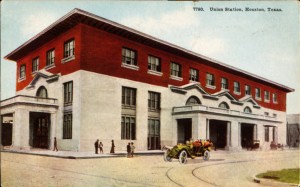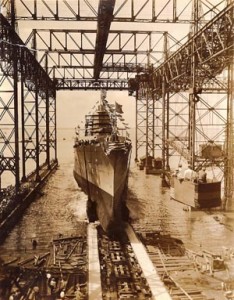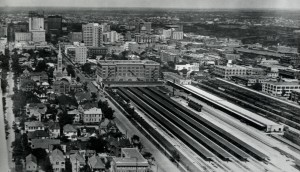
Today marks the 70th anniversary of the sinking of the heavy cruiser U.S.S. Houston (CA-30). The Houston was the flagship of the U.S. Asiatic Fleet during World War II. On March 1, 1942 she was sunk by the Japanese during the Battle of Sunda Strait, and her surviving crew members were taken prisoners of war.
In the late 1940s, the U.S.S. Houston Survivors Association was formed. In addition to publishing a newsletter for survivors and their families and attending annual reunions, the association has done much to preserve the memory of the ship and her crew. The members collected historically valuable documents and memorabilia about the Houston, which they donated to the University of Houston Libraries.
The materials donated by the association along with others acquired by the Libraries make up a number of collections in Special Collections, along with a permanent exhibit housed on the second floor of the M.D. Anderson Library. This exhibit is the location of a survivors event each year that marks the anniversary of the Houston‘s sinking. Special Collections also has an online exhibit with detailed information about the ship, her crew, the war, the prison camps, and the survivors.
Archival materials relating to the U.S.S. Houston can be found in the Cruiser Houston Collection, the William A. Bernrider Collection, the Samuel Milner U.S.S. Houston and 2nd Battalion, 131st Field Artillery Papers, and the Captain Albert H. Rooks Papers.
For more coverage of the anniversary and related events, see the Bayou City History blog, the Houston Chronicle, and the Cypress Times.
Dr. Jagdish Mehra was a prominent historian of modern physics who published books on physics and scientists and organized a number of scientific conferences. His interests were not limited to physics, however, and ranged across the sciences and humanities, and he routinely assembled representatives from the two worlds of science and literature.
The Jagdish Mehra Collection in Special Collections contains scores of audio interviews with scientists, literary greats, philosophers, and Nobel Laureates, along with recordings of lectures given by prominent thinkers.
Audio of eight of these lectures, from the annual humanities series presented at the Southeastern Massachusetts Technological Institute, now the Univeristy of Massachusetts, Dartmouth, is now available in the UH Digital Library. This collection features a diverse range of speakers, including anthropologist Margaret Mead, physicist and philosopher Gerald Holton, and historian Oscar Handlin.
In addition to the interviews and lectures, the Jagdish Mehra Collection contains a vast number of books, monographs and reference works on physics, mathematics, philosophy and history of science, along with thousands of reprints of original papers autographed by their authors. The manuscripts of hundreds of published and unpublished books, papers, and lectures from physicists, mathematicians, philosophers, and literati are also in the collection. See the finding aid for more details about the collection’s contents, or listen to the lectures now.
On this day in 1960, Houston was awarded a National League expansion team. That team, first called the Colt .45s, played its first game nearly two years later, on April 10, 1962. In 1965, with the opening of the Astrodome, the team became the Astros.
A major factor in bringing major league baseball to Houston was the work of the Houston Sports Association, whose detailed plans included a scale model of the Astrodome. The association was formed in 1957 by a group of men that included sportswriter, traveler, and baseball promoter George Kirksey. Kirksey held the position of Vice President of the Houston Sports Association until 1966. During that time he was instrumental in the promotion of the team and the Astrodome.
Special Collections holds the George Kirksey Papers, which include a variety of materials dealing with Kirksey’s work as part of the Houston Sports Association. These materials include press kits, correspondence, newspaper clippings, and photographs.
Today’s Houston Press features an article about Julie Grob, Coordinator for Digital Projects and Instruction, and the DJ Screw Sound Recordings Collection. The article offers some insight into the collection and DJ Screw‘s music:
“I think it [Screw’s music] does an amazing job of documenting,” explains Grob, who has a Masters in Library Science from the University of North Texas.
“The neighborhoods where a lot of guys [like Screw] come from are places that are not documented the way historically African-American neighborhoods like Fifth Ward or Third Ward are,” she says, “because it’s marginalized people and reveals a lot around or about street culture and drug culture.
“They didn’t have a more mainstream platform to put forward what they felt or were experiencing,” Grob continues. “The Screw Tapes really captured that. It didn’t come out of how record executives wanted to portray a sound. They were making the tapes for each other, about each other.
“It’s just this really genuine communication, and I came to realize that this music is so important to people because it really feels like it represents them.”
Be sure to read the rest for more details about the collection, including information about specific items and about the March exhibit, “DJ Screw and the Rise of Houston Hip-Hop.” Check it out online or pick up your own copy of the Press.
To inquire about donations, please contact Julie at jgrob@uh.edu. For updates about the exhibit and the Houston hip hop collection, follow Julie on Twitter.
Take a look at previous Coverage of the DJ Screw collection and exhibit:
DJ Screw Collection Coverage Keeps Coming
Rapper Paul Wall Visits Special Collections
Rap Icon Z-Ro Visits Special Collections
Today marks the last day of the Houston Astros‘ season, one that will go down as the team’s worst season to date regardless of the outcome of tonight’s game. It was a season that was historic in a way that teams don’t like to brag about, and as a relatively new team — they played their first season as the Houston Colt .45s in 1962 — the Astros don’t have a lot of history to look back on.

A postcard of Union Station in Houston long before the Astros started playing baseball on the grounds.
One aspect of the team that is worth talking about is the history that lives on in its 11-year-old ballpark. That’s right, history in a ball park that hasn’t even reached its adolescence. Most fans outside of Houston know the stadium as Minute Maid Park (or, in it’s former life, Enron Field), but the locals also know it as the Ballpark at Union Station. That’s because the stadium was built on the site of Union Station, a railway station located at Crawford Street between Texas Avenue and Congress Avenue that was dedicated on March 2, 1911. The railroad was vital to Houston’s growth and development, and Union Station was a key factor. Today, what was the station’s main concourse is now both the main entrance to the stadium and home to a conference center and executive offices. Astros team officials say that approximately 60 percent of fans enter the stadium through the Union Station lobby.
UH Special Collections holds photographs and illustrations of the original Union Station in the George Fuermann “Texas and Houston” Collection, which you see in this post, and which are also a part of the UH Digital Library. For a view of what Union Station looks like today, check out this picture from Wikimedia Commons.
If you’d like to know more about the renovation of Union Station as part of the building of the stadium, take a look at this article from the Houston Railroad Museum.


